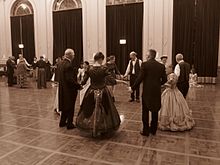Group dance
This article does not cite any sources. (June 2019) |



Group dances are danced by groups of people simultaneously, as opposed to individuals dancing alone or individually, and as opposed to couples dancing together but independently of others dancing at the same time, if any.
The dances are generally, but not always, coordinated or standardized in such a way that all the individuals in the group are dancing the same steps at the same time. Alternatively, various groups within the larger group may be dancing different, but complementary, parts of the larger dance. An exception to this generalization must be pointed out where groups of individuals are dancing independently of each other, but with the purpose of creating a "group" feeling or experience, such as might accompany various forms of ritual dancing.
Group dances include the following dance forms or styles:
- Folk dance
- Circle dance
- Contra dance
- English Country Dance
- Maypole dance
- Square dance
- Triangle Dance
- Line dance
- Novelty and fad dances
- Bunny Hop
- Chicken Dance
- Para Para
- Polonaise
- Round dance
- Rueda de Casino
- Universal Peace Dance
See also[]
- List of basic dance topics
- List of dances
- Group dances